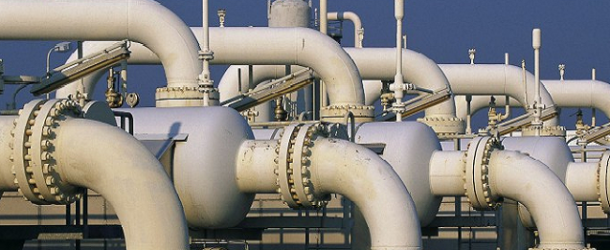The energy history of East-West energy corridor has not started with Nabucco, but Nabucco was considered a crown-jewel of the Southern Gas Corridor. Nabucco Consortium was established with Ankara Agreement in 2009 by Turkey, Romania, Bulgaria, Hungary and Austria to construct Nabucco gas pipeline with 31 bcmcapacity from Turkey via Bulgaria, Romania and Hungary to Austria. Nabucco was planned to be linked with in Erzurum, Turkey and Trans-Caspian Pipeline (TCP) in Azerbaijan to deliver Azeri and Turkmen gasto Europe to decrease the EU’s gas dependence on Russia. However, uncertainty of TCP, lack of sufficient gas, issue of cost, withdrawal of Hungarian MOL and German RWE from Nabucco, lack of political support, investment and coordination paralyzed Nabucco. Actually, Nabucco died two times, first when Azerbaijan and Turkey initiated Trans-Anatolian Pipeline in 2012, which consequently modified ‘Nabucco’ to ‘Nabucco-West’. Nabucco-West was totally buried, when Shah Deniz Consortium opted for Trans-Adriatic Pipeline in 2013 for continuation of TANAP to deliver 10 bcm/a of Azeri gas from Turkish border via Greece and Albania to Italy by 2020.
To What Extent the Revival of Nabucco is Realistic
On March 4, 2015 during the official visit of the President of Azerbaijan Ilham Aliyev to Bulgaria, Prime Minister Boyko Borisov announced Bulgaria’s intention to revive Nabucco pipeline, which is considered dead longtime ago. Borisov said that, ”We want Nabucco pipeline to be unfrozen and more precisely its part through Bulgaria”. Given Bulgaria’s 80% gas import from Russia and country is sidelined from both Nabucco and South Stream, Borisov’s stance is understandable, since both pipelines were designed to pass through Bulgaria. Therefore, Bulgaria is maneuvering for bringing pipelines into Bulgaria to play transit role to benefit from both alternative supply and transit fees. Whereas, President Aliyev did not directly touched upon what Borisov said, but he followed up with different thesis upon the question raised during press conference that, “whether revival of Nabucco means to step out of TAP framework”? President Aliyev said that, ”Though, many considered that Nabucco remained in the past after the selection of TAP, Bulgaria (as a Nabucco country) became a part of the Southern Gas Corridor via Interconnector-Greece-Bulgaria and therefore, we need to consider TAP as part of Southern Gas Corridor.The reserves of Shah Deniz, Absheron and Umid gas fields are huge enough to merge TAP with Nabucco”.
Thus, if Bulgaria is going to be part of SGC via IGB and will receive Azeri gas from TAP, then why to revive Nabucco-West? Who will finance it, if there will be interconnectorsfor region? Though the reserves of Shah Deniz are huge enough, it’s unlikely that Azerbaijan can feedboth Nabucco-West and TAP, since Nabucco-West’s capacity is bigger than TAP and most of supply is considered for TAP and its branches for the expansion capacity. Moreover, TAP is designed in a way that is possible to enhance capacity later and therefore, there is no need to construct a large-scale pipeline likeNabucco-West. Meanwhile, ”Nabucco-West countries are linked with their neighbors through bilateral connections: Austria-Slovenia, Hungary-Croatia, Hungary-Slovakia (to be built), Romania-Ukraine, Bulgaria-Serbia and Bulgaria-Macedonia”. Therefore, the matter is not revival of Nabucco-West, but bringing Azeri gas from new gas fields, such as, Umid to Nabucco-West countries (namely to Bulgaria, Romania and Hungary) through existing interconnectors between Komotini (Greece) and Stara Zagora (Bulgaria), a.k.a IGB; Sofia (Bulgaria) and Nis (Serbia); Kardam (Bulgaria) and NegruVoda (Romania); Sidirokastro (Greece) and Kulata (Bulgaria) with reverse flow.
Not Nabucco, but maybe South East European Pipeline
Alternative way, other than Nabucco-West, to transport Azeri could be South East Europe Pipeline (SEEP), which had been proposed by BP in 2011 – Azerbaijan’s Minister of Energy of Natiq Aliyev told to EurActiv. The SEEP with its planned 10 bcm capacity was based on idea of utilization of existing pipelines (interconnectors between Greece, Bulgaria, Romania, Serbia and Hungary) as an alternative to Nabucco pipeline. The capacity of pipeline might be expanded up to 20 bcm/a, in case additional Azeri gas become available from new gas fields by 2020. Therefore, revival of BP-proposed SEEP is more realisticthan Nabucco. Because, along with Azerbaijan’s SOCAR, BP also has a dominant position in Southern Gas Corridor with its 28.8% shares in Shah Deniz Consortium, 28.8% in South Caucasus Pipeline, 12% in Trans-Anatolian Pipeline and 20% in Trans-Adriatic Pipeline, which enable BP to lobby for SEEP again, as it did in 2011.
TAP is still preferred option for Azerbaijan
TAP pipeline was selected with seven out of eight evaluation criteria against Nabucco-West. The main criteria was certainly its commerciality, which managed to secure TAP as a main gas export line of Southern Gas Corridor. Because, first, the price offered to Azerbaijan’s SOCAR by countries that involved in TAP were more attractive than Nabucco-West countries offered. Second, TAP will end in Italy, whose energy grid is well connected with Central and Western European markets. As it will enable to deliver Caspian gas to Austria and Central Europe via Trans-Austria gas pipeline, Germany and France via Switzerland through reverse flow of TransitGas-TENP pipeline by linking grid and interconnector systems of Snam Rete gas and Fluxys. Third, TAP is supposed to link Bulgaria (via IGB) and Albania, Macedonia, Croatia and Bosnia-Herzegovina (via ), while Nabucco could not offer additional market perspective. Although, those Balkan countries are small enough, but they will be big market together for Azerbaijani gas. Given the lack of gas infrastructures in Albania, Montenegro and Kosovo, SOCAR will have opportunity to invest in natural gas infrastructure and downstream markets of those countries.
Whether Russia can revive Nabucco?
Whereas, Nabucco-West could be extension of recently Russian-proposed Turkish Stream as well from Turkey-Bulgaria borders. However, since operation of Trans-Balkan Pipeline (TBP) will be suspended after expiration of transit agreement on Russian gas supply through Ukraine in 2019, TBP also might be used in a reverse mode to pump Russian gas from Turkish Stream to Bulgaria, Romania and through those to Greece. Furthermore, Putin plans to revive South Stream’s onshore section again, as an extension of Turkish Stream from Bulgaria to Serbia, Hungary and Austria. Meanwhile, Greece also favored transportation of Russian gas via Interconnector-Turkey-Greece-Italy from Turkish Stream to Greece and onwards. Moreover, after receiving impressive gas price discount from Gazprom and dropping the principle of ”take or pay” for new gas contract with Russia, Hungarian PM Victor Orban declared that country is negotiating with Greece for transportation of Russian gas via new pipeline (also referred as Balkan Stream) from Greece through Macedonia, Serbia and to Hungary after gas entered Greece (possibly into ITGI) from Turkish Stream. Thus, given the reverse flow capacity of TBP, so-called Balkan Stream, perspective of ITGI and revival of South Stream’s onshore section, Russia will not need Nabucco-West either.
However, new project for Central Europe in the near future might be the ”Eastring” project, which is offered by Slovak gas pipeline operator Eustream to link Bulgaria, Romania, Hungary, Slovakia and other Balkan states each other by modernizing gas infrastructures to bring western European gas to them. The Eastring project with its 20 bcm capacity (scalable up to 40 bcm) might challenge the extension of Gazprom’s Turkish Stream along the onshore route of ex-South Stream, as it’s planned to be operational in 2018. Whereas, source of Eastring project might be even Azerbaijan (through interconnectors) and Russia (through the extension of Turkish Stream).
Can additional gas supply bring up Nabucco?
Initially, Iranian, Iraqi and Turkmen gas were also considered for Nabucco other than Azeri gas. Because, Azeri gas comes to Europe by 2020, while Iranian gas could reach Europe earlier via Nabucco from Turkey by using existing [Iran-Turkey gas] pipeline. Moreover, realization of Trans-Caspian Pipeline, which envisaged bringing Turkmen gas for SGC, remains unclear because of Caspian’s delineation problem between Azerbaijan and Turkmenistan, as well as Iran and Russia’s opposition for TCP. In fact, Iran could deliver Turkmen gas through its territories to Turkey into Nabucco. However, US and EU-imposed sanctions against Iran because of its Nuclear Program since 2005 caused to the withdrawal of European energy companies from Iran and made Nabucco partners refrain from not only bringing Iranian gas into Nabucco, but also transporting Turkmen gas through Iran. Nabucco could be realized with additional Iranian and Turkmen gas, if they have not been excluded from the project and official Brussels would not need to lobby for TCP and ”put all the eggs in the Trans-Caspian Pipeline basket”. Due to US opposition, Shah Deniz Consortium members also sidelined Iranian gas, though Iran was participating in Shah Deniz with its NICO (10%). Meanwhile, Iraq’s contribution have not been ensured yet because of instability after emergence of ISIS and given the divergence between Kurdish region and official Baghdad on exploration and transportation of gas resources of Kurdish Autonomous Region.
Conclusion
Revival of Nabucco might be possible only through the utilization of existing interconnectors between neighboring states, probably with revival of SEEP. However, even if there are interconnectors, there should be enough gas to fill them all. New gas fields of Azerbaijan are more likely in this context, however it may not be sufficient for long-term. Idea of ”Resurrection of Nabucco” is based on not only expanding Azerbaijan’s gas export capacity, but also bringing Turkmen and Iranian gas into pipeline. Whereas, U.S. sanctions made Iran’s possible contribution to the SGC unrealistic. This killed not only possibility of delivering Iranian gas, but also Turkmen gas through Iranian territories. Moreover, Iraq is still at the edge of instability after the emergence of ISIS and giventhe uncertainty of relations between Erbil and official Baghdad, there is not green light for Iraqi gas yet. Alternative gas supplier for empty interconnectorsmight be traditional gas supplier – Russian Gazprom. However, given the reverse flow capability of Trans-Balkan Pipeline, possibility to revive South Stream’s onshore section and construction of ”Balkan Stream”, Russia would not go for Nabucco-West as well.
Ilgar GURBANOV
























































